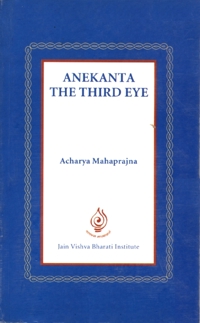
The one whose third eye is opened does not stop with the name. He goes towards the nameless.
The one whose third eye is opened, does not stop with the form. He goes towards the formless.
The one whose third eye is not opened gets stuck and entangled with name and form. Name and form… these two factors have kept all religions and philosophies entangled. The man caught in its web can neither be spiritual nor can he be one who, practices meditation. The knot formed by the name-form tangle is unravelled only when the third eye of anekanta opens. Acharya Haribhadra has said:
Pakshapato na me vire na, dweshaha kapiladisu Yuktimad vachanam yasya tasya karyaha parigrahaha.
I am not prejudiced in favour of Mahavira nor am I prejudiced against the sage Kapila. Mahavira is not my friend nor is Kapila my enemy. I respect the one whose words are full of reason.
These words could have been spoken only on the basis of anekanta. Only that person whose third eye of anekanta has been awakened can say these words. There is a text written by Acharya Haribadra called Shasravarta samuchay. In this text he has shown the mutual connection between seemingly opposing beliefs. Through this exercise he has made anekanta very powerful.
To the one whose third eye has been awakened nothing is false. His constant touchstone for truth and untruth would be: that which is relative is the truth and that which is absolute, devoid of any relativity would be false. Beyond this there is nothing else. It is on this touchstone that he accepts a belief or rejects one. He does not find out where this thought is coming from. Or who is the one who is propounding the thought. He is just concerned about whether what is being said is relative or not. If it is relative it is acceptable, if it is not relative, it is not acceptable.
Over this long period in time, great acharyas such as Acharya Samantabhadra, Acharya Vadidevasuri, Acharya Hemchandra have given very comprehensive expositions of the vision of anekanta and the many possibilities of the awakening of the third eye.
Today there are many more possibilities because today the world of knowledge is far more encompassing.
The one whose third eye is not opened gets stuck and entangled with name and form. Name and form… these two factors have kept all religions and philosophies entangled. The man caught in its web can neither be spiritual nor can he be one who, practices meditation. The knot formed by the name-form tangle is unravelled only when the third eye of anekanta opens. Acharya Haribhadra has said:
Pakshapato na me vire na, dweshaha kapiladisu Yuktimad vachanam yasya tasya karyaha parigrahaha.
I am not prejudiced in favour of Mahavira nor am I prejudiced against the sage Kapila. Mahavira is not my friend nor is Kapila my enemy. I respect the one whose words are full of reason.
These words could have been spoken only on the basis of anekanta. Only that person whose third eye of anekanta has been awakened can say these words. There is a text written by Acharya Haribadra called Shasravarta samuchay. In this text he has shown the mutual connection between seemingly opposing beliefs. Through this exercise he has made anekanta very powerful.
To the one whose third eye has been awakened nothing is false. His constant touchstone for truth and untruth would be: that which is relative is the truth and that which is absolute, devoid of any relativity would be false. Beyond this there is nothing else. It is on this touchstone that he accepts a belief or rejects one. He does not find out where this thought is coming from. Or who is the one who is propounding the thought. He is just concerned about whether what is being said is relative or not. If it is relative it is acceptable, if it is not relative, it is not acceptable. Over this long period in time, great acharyas such as Acharya Samantabhadra, Acharya Vadidevasuri, Acharya Hemchandra have given very comprehensive expositions of the vision of anekanta and the many possibilities of the awakening of the third eye.
Today there are many more possibilities because today the world of knowledge is far more encompassing.
 Acharya Mahaprajna
Acharya Mahaprajna
